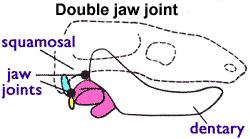Order Therapsida | Phylum Chordata Suborder Cynodontia | |
 | ||
Clade †MorganucodontaKermack, Mussett & Rigney, 1973 | ||
Morganucodonta ("Glamorgan teeth") is an extinct order of primitive mammaliaformes similar to crown-group mammals. Their remains have been found in southern Africa, Western Europe, Arizona and China. The morganucodonts were most likely insectivorous and nocturnal, seeking prey while avoiding predators that were usually active by day. Such a trait may have been inherited by their descendants to avoid the predatory dinosaurs, though some of the latter were nocturnal as well.
Contents
Anatomy
Morganucodonts were equipped with an unusual structure, the "double-joint", which meant that the jaw articulation would be made up of the dentary-squamosal joint as well as a quadrate-articular one. The articular and quadrate bones would eventually become the malleus and incus respectively. There is a trough at the back of the jaw that houses postdentary bones; such bones are absent today in mammals (all living mammals have a jaw that is composed of a single bone, one of the defining features of Mammalia).
Unlike Sinoconodon and the therapsids, morganucodont teeth were diphyodont (meaning that they possessed two sets of teeth as in all living mammals) and not polyphydont (meaning that the teeth are constantly replaced, as in reptiles). Furthermore, the primitive postcanine teeth have been replaced by true molars and premolars. The teeth are structured in such a way that occlusion happens by the lower cusp "a" fitting anteriorly to upper cusp "A", between "A" and "B". This occlusion pattern is also seen in the unrelated triconodontids, but it is by no means universal among morganucodonts; Dinnetherium, for example has an occlusion mechanism closer to that of gobiconodontids (also unrelated), in which molars basically alternate. Wear facets are present.
The septomaxilla, a primitive feature also found in Sinoconodon, is found in morganucodonts, as well as a fully ossified orbitosphenoid. The anterior lamina is enlarged. The cranial moiety of the squamosal is a narrow bone that is superficially placed to the petrosal and parietal. Unlike its predecessors, the morganucodonts have a larger cerebral capacity and a longer cochlea.
The atlas elements are unfused; there is a suture between the dens and axis. The cervical ribs are not fused to the centra. The coracoid and procoracoid, which are absent in therians, are present. The head of the humerus is spherical as in mammals, but the spiral ulnar condyle is cynodont-like. In the pelvic girdle, the pubis, ilium and ischium are unfused. At least Megazostrodon and Erythrotherium are unique among mammaliformes for lacking epipubic bones, suggesting that they didn't have the same reproductive constraints.
Classification
Because morganucodonts possessed the dentary-squamosal jaw joint, systematists like G. G. Simpson (1959) considered the morganucodonts to be mammals, and most contemporary paleontologists continue to use this classification. Others, however, limit Mammalia to the crown group and so exclude more basal mammaliaform orders like Morganucodonta.
†Morganucodonta Kermack, Mussett & Rigney 1973 sensu Kielan-Jaworowska, Cifelli & Luo 2004
